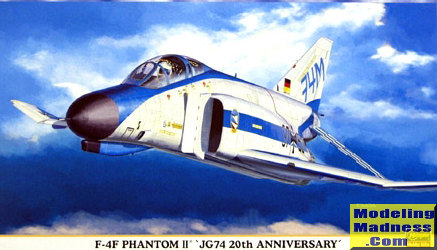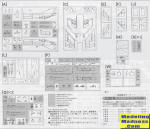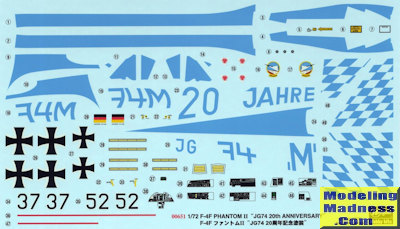
Hasegawa 1/72 F-4F Phantom II 'JG 74 20th Anninversary'
| KIT #: | 00651 |
| PRICE: | 2600 yen SRP |
| DECALS: | One option |
| REVIEWER: | Scott Van Aken |
| NOTES: | 2003 Limited Edition |

| HISTORY |
To most knowledgeable and intelligent people, one of the finest jets of the Cold War is the F-4 Phantom II. Those lacking proper perception willundoubtedly differ in this matter, however, it isn't too late to come to yoursenses! :o)
Other than perhaps the Mig-17 or Mig-21, no other post-Koreanwar jet has been built in greater numbers. Certainly no other non-Sovietdesigned aircraft. There must have been a reason for it. It certainly isn'tsimplicity or ease of maintenance. The Phantom was one of the last Westernfighters where the airframe was designed first and then room was found for otherequipment. Nowadays, ease of maintenance is as important as any other factor. Itcertainly wasn't designed to be stealthy. Nothing like two smoke trailsfollowing several tons of hurtling metal to make yourself visible! It alsowasn't designed to be quiet. If you have ever been around the beast withoutproper hearing protection, your ears will definitely be ringing.
What made it such a success is that it was able to perform avariety of missions and perform them all well. Probably your first decentmulti-mission aircraft. It was an interceptor, a (unwilling) dogfighter, asuperb ground attack aircraft, a night fighter, a level bomber, a SAMsuppression aircraft, and a blast to fly. Before that, aircraft were generallyspecialized. After the Phantom, there were still purposefully built aircraft,but it lead the way to today's multi-mission aircraft.
Though mostly gone from the inventories of the world's air forces, The F-4 is still being flown by the Greeks, Turks and the Iranians. The Japanese have theirs in ready reserve as do the South Koreans in case of issues with China. Israel may also still have some operating. The Iranian fleet recently was upgraded (some say with help from IAI) and both the Greek and Turk Phantoms have also had upgrades. Turkey has the largest Phantom fleet currently flying. One of the buyers of new Phantoms back in the early 1970s was Germany. Their F-4Fs were identical to the the USAF F-4E aside from not having Sparrow capabilities. The ICE program of the early 1990s upgraded the avionics of extant airframes and included AMRAAM installation. The type was retired from squadron service in 2013, but some are still flying in specialty roles.
| THE KIT |
 The gun Phantom has done well for Hasegawa. I'm not sure of the number of limited edition boxings they have done of this kit, but I'm betting it is over 50. This particular one contains a number of sprues that are identical to other boxings of later F-4E/F-4Fs. Since this is a special scheme plane, the build instructions leave off all the underwing bits, but for those wanting a standard plane using aftermarket decals, there are a few things I should point out.
The gun Phantom has done well for Hasegawa. I'm not sure of the number of limited edition boxings they have done of this kit, but I'm betting it is over 50. This particular one contains a number of sprues that are identical to other boxings of later F-4E/F-4Fs. Since this is a special scheme plane, the build instructions leave off all the underwing bits, but for those wanting a standard plane using aftermarket decals, there are a few things I should point out.
The main bit of info is that this is a late F-4E/F. That means that it has the slatted wings with the later wing tip pieces as well as the slatted tail planes with the reinforcement arrow. No Vietnam era planes with this one as the bits are not there. What is included and not used are both the early centerline tank and the later F-15 style version. I'm not sure if the F-4F used this later tank, but photos will be helpful in this regard. You also get the TIESO camera installation and LORAN antenna as well as the flare/chaff dispensers for the inboard missile pylons.
I've discussed the basic kit several times in other previews, so won't go into details. Where this kit can ben efit from aftermarket is in the cockpit simply by a good set of resin seats and perhaps a photo etch upgrade as instruments and such are decals. As with most Hasegawa jet kits, missiles will have to come from some other source such as a weapons set.
efit from aftermarket is in the cockpit simply by a good set of resin seats and perhaps a photo etch upgrade as instruments and such are decals. As with most Hasegawa jet kits, missiles will have to come from some other source such as a weapons set.
Instructions are well done with Gunze paint references. The decal sheet has markings for one plane and the modeler will need to mix paint to match the blue on the decals as the markings suite is not comprehensive. Still, it is a fetching scheme and one that will be easy to mask once the paint is matched.
| CONCLUSIONS |
Even if one doesn't do the kit markings, this one is a good basis for any later F-4E/F. Finding aftermarket decals will not be difficult. The kit is a bit fiddly thanks to all the inserts, but the end result is well worth the time you put into it. So far, no one has produced a 1/72 F-4 that is better than this, at least in the mind of many fans.
June 2016 Copyright ModelingMadness.com Thanks to your editor for the preview kit. If you would like your product reviewed fairly and fairly quickly, please contactthe editor or see other details in the